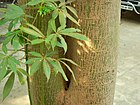Note: This is a project under development. The articles on this wiki are just being initiated and broadly incomplete. You can Help creating new pages.
Difference between revisions of "Ceiba pentandra"
| Line 76: | Line 76: | ||
==External Links== | ==External Links== | ||
| − | * [ ] | + | * [http://www.flowersofindia.net/catalog/slides/Kapok%20Tree.html Ceiba pentandra on flowersofindia.net] |
| − | * [ ] | + | * [https://indiabiodiversity.org/species/show/229096 Ceiba pentandra on indiabiodiversity.org] |
| − | + | ||
[[Category:Herbs]] | [[Category:Herbs]] | ||
[[Category:Pages without herbs images]] | [[Category:Pages without herbs images]] | ||
Revision as of 18:40, 10 April 2020
Ceiba pentandra is a deciduous tree with a pagoda-shaped, thin crown. It can become a very large tree, capable of reaching a height of 70 metres. The straight, cylindrical bole can be 100 - 300cm in diameter. it is usually spiny, and sometimes has prominent buttresses.
Contents
- 1 Uses
- 2 Parts Used
- 3 Chemical Composition
- 4 Common names
- 5 Properties
- 6 Habit
- 7 Identification
- 8 List of Ayurvedic medicine in which the herb is used
- 9 Where to get the saplings
- 10 Mode of Propagation
- 11 How to plant/cultivate
- 12 Commonly seen growing in areas
- 13 Photo Gallery
- 14 References
- 15 External Links
Uses
Uterine bleeding, Dysentery, Diarrhoea, Oedema, Diarrhoea, Dysmenorrhoea, Hypertension.
Parts Used
Seeds, Tender leaves, Flowers, Wood ashes.
Chemical Composition
Common names
| Language | Common name |
|---|---|
| Kannada | |
| Hindi | |
| Malayalam | |
| Tamil | |
| Telugu | |
| Marathi | |
| Gujarathi | |
| Punjabi | |
| Kashmiri | |
| Sanskrit | |
| English |
Properties
Reference: Dravya - Substance, Rasa - Taste, Guna - Qualities, Veerya - Potency, Vipaka - Post-digesion effect, Karma - Pharmacological activity, Prabhava - Therepeutics.
Dravya
Rasa
Guna
Veerya
Vipaka
Karma
Prabhava
Habit
Identification
Leaf
| Kind | Shape | Feature |
|---|---|---|
Flower
| Type | Size | Color and composition | Stamen | More information |
|---|---|---|---|---|
| {{{5}}} |
Fruit
| Type | Size | Mass | Appearance | Seeds | More information |
|---|---|---|---|---|---|
Other features
List of Ayurvedic medicine in which the herb is used
Where to get the saplings
Mode of Propagation
How to plant/cultivate
A plant of the moist tropics, where it is found at elevations up to 1,200 metres, though productivity starts to decline above 460 metres.[3]
Commonly seen growing in areas
Moist evergreen and deciduous forests, Dry forests, Secondary forests, Pioneer species.
Photo Gallery
References
- ↑ ["chemistry"]
- ↑ ["morphology"]
- ↑ Cultivation
External Links
- Ayurvedic Herbs known to be helpful to treat Uterine bleeding
- Ayurvedic Herbs known to be helpful to treat Dysentery
- Ayurvedic Herbs known to be helpful to treat Diarrhoea
- Ayurvedic Herbs known to be helpful to treat Oedema
- Ayurvedic Herbs known to be helpful to treat Dysmenorrhoea
- Ayurvedic Herbs known to be helpful to treat Hypertension
- Herbs with Seeds used in medicine
- Herbs with Tender leaves used in medicine
- Herbs with Flowers used in medicine
- Herbs with Wood ashes used in medicine
- Habit - Deciduous tree
- Index of Plants which can be propagated by Seeds
- Index of Plants which can be propagated by Cuttings
- Herbs that are commonly seen in the region of Moist evergreen and deciduous forests
- Herbs that are commonly seen in the region of Dry forests
- Herbs that are commonly seen in the region of Secondary forests
- Herbs that are commonly seen in the region of Pioneer species
- Herbs
- Pages without herbs images





